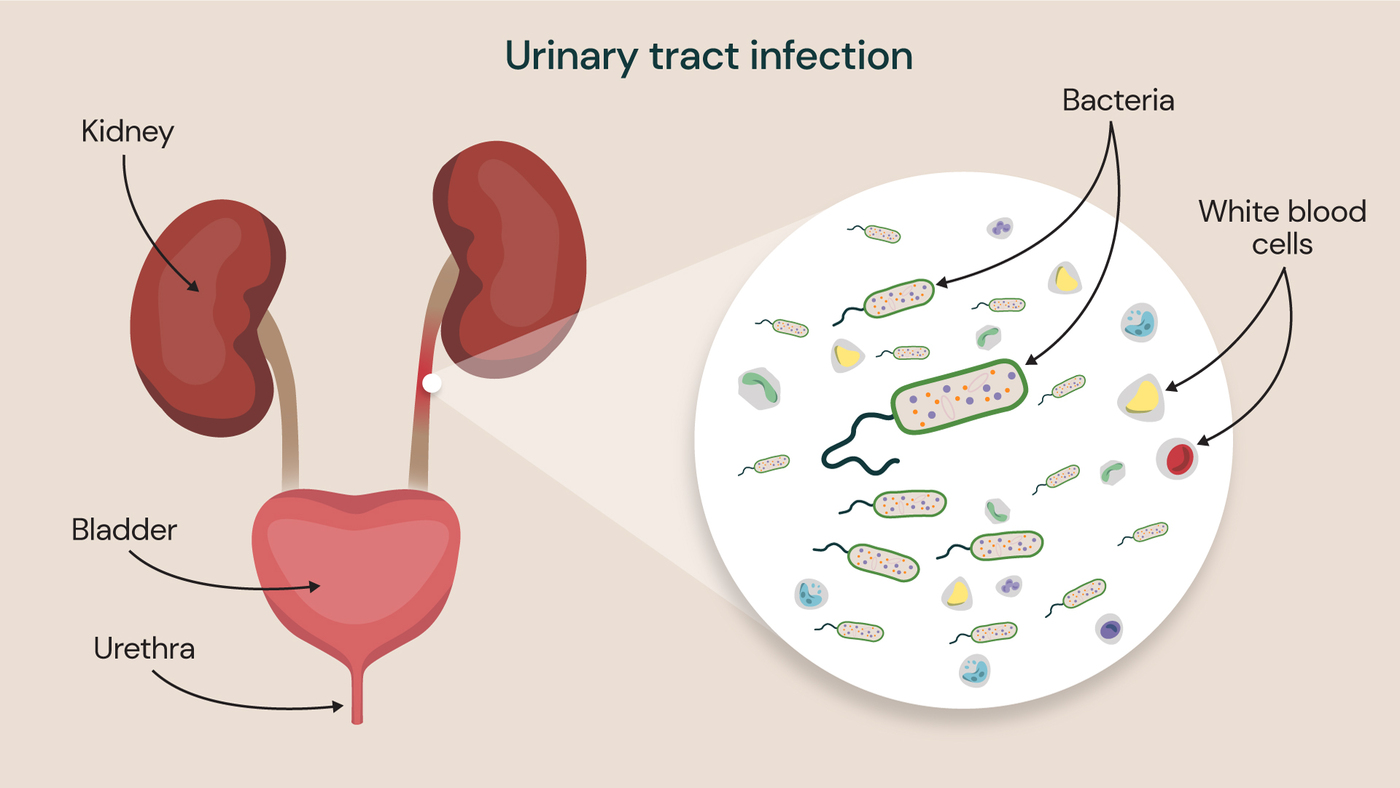What is a UTI?
UTI stands for urinary tract infection. It is a common type of infection that affects any part of your urinary tract – the system that contains the bladder, urethra (the tube that runs from the bladder out of the body) and kidneys.
While UTIs affect both adults and children, they are more common in children as they don’t always have the greatest skill when it comes to cleaning themselves after using the toilet.
Though UTIs are rarely serious, they can be uncomfortable and children often need UTI treatment if their symptoms don’t resolve themselves within a few days.

Types of UTIs
UTIs can be broadly categorised into two types:
- upper UTIs – these affect the kidneys, or the ureters, which are the tubes connecting the kidneys to the bladder
- lower UTIs – these affect the bladder (a condition more commonly referred to as cystitis) and the urethra
UTIs are very common in children, with around 2.7% of girls and 1% of boys experiencing a UTI by the time they reach the age of 7. UTIs can happen once, or some children will experience UTIs regularly.
UTI symptoms in children
There are many different symptoms associated with UTIs. As with many other health issues, it’s not always easy to tell if a child has a UTI because they may be too young to communicate how they are feeling.
For this reason, it’s a good idea for parents to know the signs of a UTI in their child. These include:
- pain or a burning feeling when they urinate
- needing to pee more often than usual during the night
- pee that looks cloudy, dark or a strong smell
- needing to pee suddenly and feeling as though they can’t wait
- needing to pee more often than usual
- blood in their pee
- pain in their lower tummy, or in their back just under their ribs
- a high temperature or fever
- a very low temperature of under 36°C
- bedwetting or wetting themselves
- vomiting
- appearing generally unwell
If your child has a very high temperature or signs of a fever (feeling hot and shivery), has a very low temperature below 36°C, seems confused or drowsy, has pain in their lower tummy or back, or blood in their pee, it could be a sign of a kidney infection.
Kidney infections can be serious as without treatment, they can lead to a life-threatening condition called sepsis. If your child has any of these symptoms, don’t delay and seek medical help right away.
What causes a UTI in children?
Nearly all UTIs in children are caused by bacteria from the digestive system getting into the urethra (the tube that allows urine to leave the body). This happens when a child wipes their bottom after a bowel movement and faeces come into contact with the genitals, or because of contamination during a nappy change.
Girls are more likely to experience UTIs because their urethra is shorter than boys. Many children experience UTIs as a result of ‘holding’ their pee. Reluctance to go to the toilet, even though they need to, is known as dysfunctional elimination syndrome and is a common reason for UTIs to occur. Similarly, so is constipation, which puts pressure on the bladder and prevents it from being emptied fully.
Finally, a very small number of children may have a condition called vesicoureteral reflux. This is where urine leaks back up from the bladder into the ureters and kidneys and happens because of a problem with the valves in the ureters. This condition is rare but requires surgical intervention.
Diagnosing a UTI in children
A UTI can nearly always be diagnosed by a child’s symptoms along with a sample of their urine. You may be asked to bring this with you, in a clean container, to your appointment.
In some cases, a paediatric urologist may decide that the information you’ve provided about your child warrants some additional tests, such as an ultrasound of their urinary tract.
UTI treatment for children
Most children with a UTI will be seen by their GP and offered medical treatment without the need to see a specialist. The usual treatment for a UTI in children is a course of antibiotic medicine which is taken at home. This may be in oral suspension or tablet form, depending on the age of your child and their ability to take medicine. As with any antibiotics, it’s essential that your child completes the full course of treatment.
For very young children under three months old, or for those with very severe symptoms, hospital admission may be recommended. This enables them to receive antibiotics intravenously (through a needle in their arm), which gets medicine into their bodies quicker.
In addition to antibiotics, your child may also be recommended to take pain relief such as paracetamol or ibuprofen, rest and drink plenty of water.
If your child’s UTI is chronic (recurring), atypical, or if it is suspected that they have an anomaly with their urinary tract or anal tract, they will be referred to urology specialists for further investigation and/or treatment.
To determine which course of treatment is the best for your child, our paediatric urologists will examine your child’s bladder and bowel habits, performing an ultrasound scan and, sometimes, more specialist urodynamic tests. However, our specialists aim to treat UTIs in children with medical intervention in the first instance.
Surgery is a last resort in the treatment of UTIs and would only be recommended for vesicoureteral reflux or urinary blockage, and only after other treatment options have been explored.
Procedures which may be recommended to treat recurrent UTIs include:
- deflux injections
- Botox injections to the bladder
- pyeloplasty
- ureteric re-implantation
How long does a UTI last?
Most UTIs in children will last less than 48 hours once treatment with antibiotics has started. However, some children may find that their UTI comes back (especially if they don’t finish the full course of antibiotics), or that they get a second UTI in the space of 6 months.
If this happens, your child may need to have a different antibiotic prescribed for them, or an extended course of very low-dose antibiotics. Your child may also be referred for further tests to rule out a medical cause of their UTIs.
In some cases, a UTI can resolve itself. However, if your child isn’t feeling any better after a few days, it’s important to make an appointment to talk to a paediatric urologist about treatment.
How to avoid a UTI: tips for parents and their children
The good news is that there are some things that you can do to help reduce the risk of your child experiencing a UTI. These include:
- breastfeeding your baby — if you are able to, breastfeeding a baby has been shown to improve their immune system and reduce their risk of constipation
- further reduce your child’s risk of constipation by making sure they drink plenty of water and get enough fibre in their diet
- encourage your child to wipe their bottoms from front to back to prevent faeces from spreading forward into their urethra
- make sure your child drinks plenty of water and goes to the toilet regularly and doesn’t ‘hold’ their pee
- don’t wash your child/let them wash themselves using scented soap or bubble bath, as these increase the risk of a UTI
- if your child is still wearing nappies, be extra careful to keep faeces away from your child’s urethra
- choose cotton underwear for your child, as synthetic and nylon materials can encourage bacteria to grow
Locations
Our children's urology experts can see young patients at the following locations:
Discover our team of children's urology experts
With a team of expert urologists and the very latest facilities, Evelina London delivers specialist care for children with bladder problems, balanitis and genital abnormalities.
Designed specifically with children in mind, our paediatric urology services ensure your child receives the very best care.
